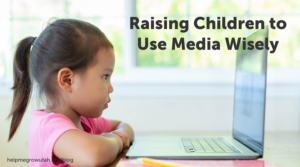 It may seem that there are only two ways to interact with technology in your family: by living in the stone age and avoiding it altogether, or by giving the kids free rein on their own tablets and iPhones and having the TV always playing in the background. Which one is right?
It may seem that there are only two ways to interact with technology in your family: by living in the stone age and avoiding it altogether, or by giving the kids free rein on their own tablets and iPhones and having the TV always playing in the background. Which one is right?
The truth according to the research in the book “Media Maze” by Eric Rasmussen is that neither is the best environment to produce adults that use media wisely. Technology is an integral part of our society today in school, in work, and in staying connected to loved ones. Avoiding it altogether isn’t effective because kids will need to learn to use it at some point. But expecting a child to understand how to use media in a healthy way without being taught how to do so doesn’t make a lot of sense. You as your child’s parent have the responsibility to teach them how to become a successful adult and teaching about media is an essential part of that.
First of all, there are limits on how much screen time children should have. You can find those limits in one of our previous blog posts. But raising a child who can use technology wisely is more about quality and guidance than time. Through parental monitoring or supervision, we can help children have a healthy experience with media. There are multiple kinds of parental monitoring (which you can find in the book mentioned above), but today we will just talk about two of them.
- Restrictive monitoring
- Active monitoring
Restrictive monitoring is what it sounds like – restricting the time or content of media for children. I remember my parents only let us watch the PBS channel and play video games that had Mario in them. This type of monitoring is important, especially when children are really young because you don’t want them being exposed to things that are too mature for them or spending a disproportionate amount of time on media instead of other activities that are important for their development. Giving kids reasons for your rules is also important in helping them avoid negative media effects (explained more here). But if this is the only kind of monitoring used children may be unprepared to handle media when they are on their own and out of their parents’ supervision; so active monitoring is also necessary.
Active monitoring is a bit more time-consuming as it requires you to engage in the media with your child, and it calls for a lot more thought into what you are watching/playing. Active monitoring is guiding children to become critical thinkers when it comes to media. It’s helping them recognize that not everything you see on TV or in a video game is acceptable or realistic. It’s talking to them before starting a movie and explaining that just because the hero is fighting with others it doesn’t mean that it is okay for the child to fight. This type of monitoring may show up in the form of a commercial for a children’s toy and asking “Do you think that toy is really as fun as they make it look on T.V.?” You may explain photoshop and ask your child “Do you think that woman really looks like that or has she been enhanced?”
Another part of active monitoring is teaching children to be proactive with what they might encounter in media. You might make a plan with them about what to do if they see something inappropriate on the internet or if a friend invites them to play an “M” rated video game. You could even create a family media use plan so that you can support one another in your media goals. Make sure your kids know they can talk to you without you becoming angry if they are exposed unintentionally to inappropriate media or if they fail to follow their plan exactly. Encourage them to try again and help them see the progress they have made. Take the time to talk about their experience with media often and remind children of their plan as they get on the computer or leave to go to a friend’s house. Be patient with them and remember that they are learning and doing their best.
It’s important to monitor kids’ media, but not just to protect them and stop there. We are responsible for preparing kids to successfully navigate a life filled with media. To learn more about how to help yourself and your children use media for good you can read the book “Media Maze” by Eric Rasmussen.





